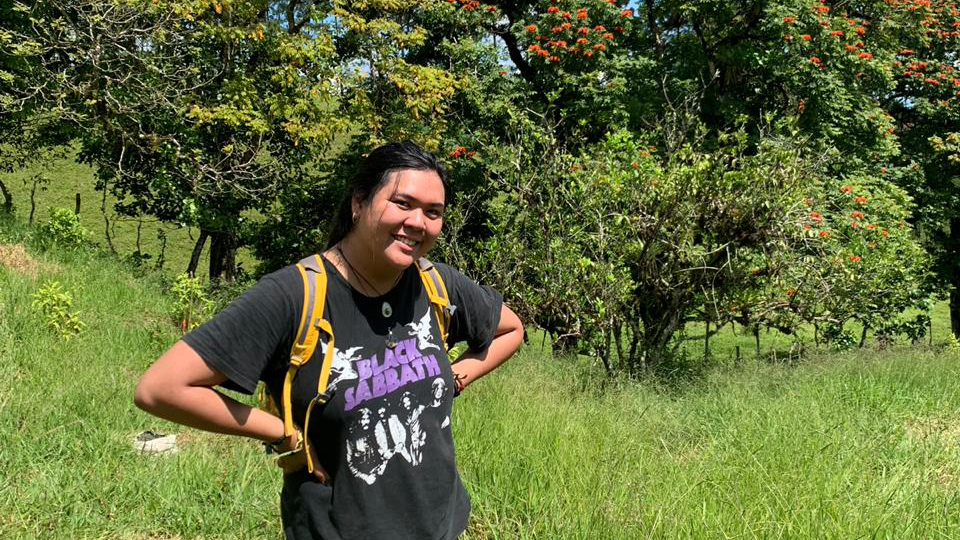The process of becoming: Doctoral student studies evolution in rainforest lizards

Janelle Talavera sat in the back of her biology class at California State University, Northridge, close to the door and utterly disengaged.
As a first-year student, she has opted for a nursing major as a kind of default, unsure what other paths lay open. Hence the required biology class, which left her bored out of her mind — until the professor began to discuss evolution.
She sat up and listened, fascinated.
“I couldn’t explain it. From then on, I sat in the front of the classroom and went to my professor’s office hours every week, sometimes more than once a week,” said Talavera, now a doctoral student in Binghamton University’s biological sciences program. “I changed my major to ecology and evolutionary biology and pursued every single opportunity I could, and never looked back. And now, here I am in a PhD program.”
Evolution in real time
Talavera came to Binghamton specifically to study with Assistant Research Professor Lindsey Swierk, whose research interests are similar to her own. The Los Angeles local studies reproductive isolation and speciation in water anoles, a type of aquatic lizard that lives primarily in the Costa Rican rainforest.
Male water anoles have brightly colored dewlaps, which they use to attract female attention. These colors can vary among water anole populations. Would otherwise isolated populations with different dewlap colors mate freely with each other, if given the chance? And, if not, does that mean that they are in the process of becoming different species?
That’s what Talavera hopes to discover.
This spring, she received several awards to fund her research in Central America, including the $3,000 Howard McCarley Student Research Award from the Southwestern Association of Naturalists, a $3,000 award from the Society of Systematic Biologists and a $1,000 award from Sigma Xi, as well as a $1,000 award from Binghamton’s Department of Biological Sciences.
In Costa Rica, she plans on conducting behavioral trials to determine the colors preferred by female anoles in different populations. Talavera, who is co-advised by Assistant Professor of Biological Sciences Thomas Powell, will also gather genetic data to determine whether these isolated lizard populations are, in fact, different species.
Evolution happens in real time, all around us, and not just on the level of bacteria and viruses. Anoles live in aquatic environments, and they can become isolated as they disperse to different, unconnected streams. These isolated populations can experience different genetic mutations — a natural occurrence — as they adapt to different environments. Enough mutations, selection and isolation, and a new species is born.
Talavera’s research is exciting because she’s looking at the connections among an animal’s behavior, its natural environment and the bird of new species, Swierk said.
Animal behavior can play a powerful role in isolating populations, Swierk said.
“If two populations of water anoles evolve signals to communicate in different types of environments, they may no longer ’speak the same language’ if they subsequently interact. So, Janelle’s research can help us explore how animal communication, and possibly the ensuing isolation and speciation, could be affected as natural environments change,” Swierk said.
The conservation of that biodiversity is also one of Talavera’s motivators. Anoles, after all, live in the rainforest, an environment under threat.
“I love discovering all the processes that lead to a new species, as well as what hinders these processes,” she said. “It’s always messy and there’s never one straight answer. I just love to figure things out and understand why our world is so rich with biodiversity, and how we can maintain it.”
There’s another kind of diversity she hopes to promote on her journey as well: in the classroom.
A first-generation Filipino American, Talavera is also the first in her family to attend graduate school. She hopes to follow in Swierk’s footsteps one day, conducting research in her own lab and mentoring students from marginalized groups to show them the possibilities that await them in the sciences.
“I didn’t know research was a thing until I was 20 years old. I never thought I could be a scientist and I was never an outdoorsy person, either,” she reflected. “I want (students) to know that you can be whatever you want to be, and that you belong in STEM, too.”
